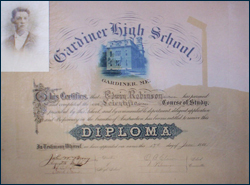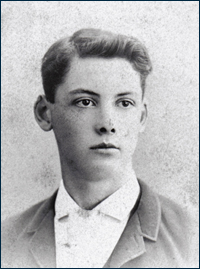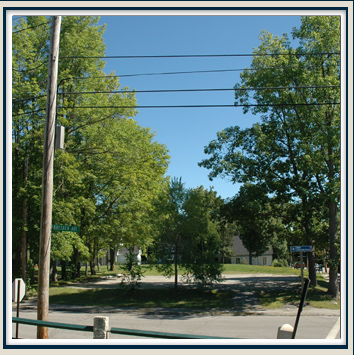Gardiner High School,
Corner of School Street and Dresden Avenue
 |
Gardiner High School was erected in 1870 at Dresden Avenue and School Street to replace the 1822 Lyceum, which had served as the community’s high school since the 1850s. Designed by Portland architect Francis H. Fassett, this brick mansard-roofed building was the city’s high school until 1921, when a new facility was constructed on an adjacent lot. During the next four decades, the old high school was used as a junior high and for overflow of high school classes. The building was torn down in 1969, just short of its centennial year. Its most famous graduate was poet Edwin Arlington Robinson, a member of the class of 1888.
|
Robinson entered high school when he was thirteen. The school stood on the eastern side of the Gardiner Common, adjoining the elm-shaded Episcopal graveyard where the Gardiners and Richardses waited patiently for Gabriel’s trump. In this cheerless structure of red brick with mansard roof line in its “most beefy and truculent form,”
 |
E.A. Robinson's High School Diploma
|
Robinson took the scientific course because it absolved him from Greek, a subject necessary for admission to college. His father had no intention of sending him to college and after Dean’s failed life said that college did no one any good. Chemistry amused him to the point that he made miniature bombs. In high school he stood out when his interest in Virgil’s Aeneas became apparent. Math did not excite him until he developed a crush on the algebra teacher, Lizzie Austin.
 |
Lizzie Austin, Robinson's high school Algebra teacher. She was a cousin of Dr. Alanson Schumann. Collection: Danny Smith.
|
“He irritated his teachers by the absorption with which he stared out of the window, until they recognized philosophically that Robinson was Robinson, and they might as well make the best of it.” When Robinson was a senior in high school, he immortalized friendship with Ed Moore and Arthur Gledhill by forming the League of Three. They acquired the unprecedented privilege to work outside of study hall and wandered off regularly to the belfry where they opened the scuttle in the roof to let out the smoke from their illicit pipes as they carved the triangle with the figure of “3” on it—their badge. They had no aims other than social or convivial. They played cribbage in evenings, gossiped about girls “with the discrimination of eighteen,” and talked of books they were reading. When they read Cooper’s Virgil, they swore “by the Styx even as the gods.” (Hagedorn, pages 30–1 and 41–2)
 |
Edwin Arlington Robinson in 1888 in his high school graduation photograph.
|
This selection, “Children of the Night” has not been made merely because it is evocative of the site as some of the poems included in this list nor has it a direct statement to link it to a site. Yet it was selected by Laura E. Richards in her chapter “A Posey of Friendship” as a poem that has a lot to say about Robinson’s tortured relationship with the people of Gardiner and their hesitant pride in him. Laura Richards chided him about the optimistic message in the poem when Robinson was given to morose introspection. He later dropped the poem from his Collected Works, saying that he had said the same thing better in “The Man Against the Sky.” (Letter, Robinson to Laura E. Richards, January 17, 1922) It was one of the favorite Robinson poems of Laura Richards.
< previous : return to map : next >
|
Children of the Night
For those that never know the light,
The darkness is a sullen thing;
And they, the Children of the Night,
Seem lost in Fortune’s winnowing.
But some are strong and some are weak,—
And there’s the story. House and home
Are shut from countless hearts that seek
World-refuge that will never come.
And if there be no other life,
And if there by no other chance
To weigh their sorrow and their strife
Than in the scales of circumstance—
’T were better, ere the sun go down
Upon the first day we embark
In life’s embittered sea to drown
Than sail forever in the dark.
But if there be a soul on earth
So blinded with its own misuse
Of man’s revealed, incessant worth,
Or worn with anguish that it views
No light but for a mortal eye—
No rest but of a mortal sleep—
No God but in a prophet’s lie—
No faith for “honest doubt” to keep—
If there be nothing, good or bad,
But chaos for a soul to trust,—
God counts it for a soul gone mad,
And if God be God, He is just.
And if God be God, He is Love:—
And though the Dawn be still so dim,
It shows us we have played enough
With creeds that make a fiend of Him.
There is one creed, and only one,
That glorifies God’s excellence;—
So cherish, that His will be done,
The common creed of common sense.
It is the crimson, not the gray,
That charms the twilight of all time;
It is the promise of the day
That makes the starry sky sublime;
It is the faith within the fear
That holds us to the life we curse;—
So let us in ourselves revere
The Self which is the Universe!
Let us, the Children of the Night,
Put off the cloak that hides the scar!—
Let us be Children of the Light,
And tell the ages what we are!

< previous : return to map : next >
|





